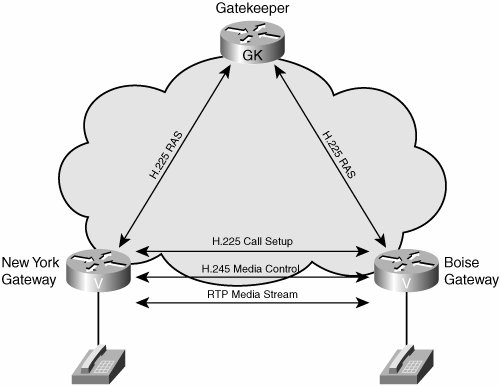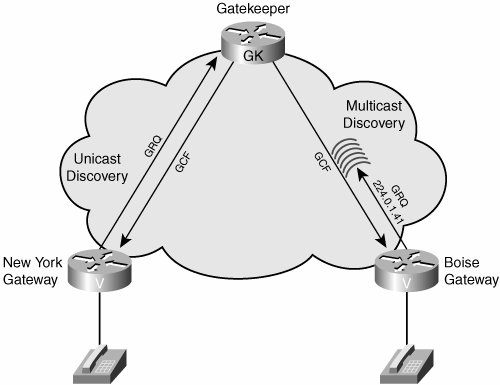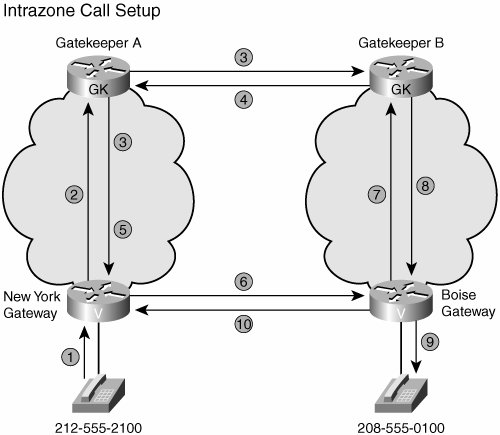Gatekeeper Signaling
Cisco IOS gatekeepers use a variety of signaling methods to provide control capabilities, redundancy, and extensibility of the H.323 network. These include the H.323 Registration, Admission, and Status Protocol (RAS), the Gatekeeper Update Protocol (GUP), and the Gatekeeper Transaction Messaging Protocol (GKTMP).
RAS Signaling
Gatekeepers are H.323 devices that use the RAS protocol to communicate with Cisco voice gateways. RAS is a subset of the H.225 signaling protocol.
Call control and call setup are also done using H.225 signaling. If the call control/call setup H.225 messages go directly between gateways (not through the gatekeeper), it is known as direct endpoint signaling. Some gatekeeper implementations support gatekeeper-routed call signaling (GKRCS). With GKRCS, all H.225 signaling (RAS and call control/call setup) is passed from the gateway to the gatekeeper. No H.225 messages are sent directly between gateways.
Note
Cisco gatekeeper implementations do not support GKRCS. Only direct endpoint signaling is supported.
H.245 signaling is another subset of H.323 that is used for media control. H.245 flows directly between gateways to facilitate setup of the media stream.
Figure 16-2 shows the H.323 signaling and media flow for a typical voice call.
Figure 16-2. H.323 Signaling Flow

H.225 RAS uses defined message types to communicate between the gatekeeper and the gateway. Table 16-1 lists the specific RAS messages.
|
Message Type |
Message Code |
Message Code Expansion |
Description |
|---|---|---|---|
|
Gatekeeper discovery messages |
GRQ |
Gatekeeper Request |
Message that a gateway sends during the gatekeeper discovery process. |
|
GCF |
Gatekeeper Confirm |
Reply from the gatekeeper to the gateway, which indicates the transport address (port) of the gatekeeper RAS channel. |
|
|
GRJ |
Gatekeeper Reject |
Reply from the gatekeeper to gateway that rejects the gateway request for registration. Usually due to gateway or gatekeeper configuration error. |
|
|
Gatekeeper registration messages |
RRQ |
Registration Request |
Message sent from a gateway to the gatekeeper. |
|
RCF |
Registration Confirm |
Message acknowledging that the gatekeeper has allowed gateway registration. |
|
|
RRJ |
Registration Reject |
Message acknowledging that the gatekeeper has not allowed the gateway to register. |
|
|
URQ |
Unregister Request |
Message sent from a gateway or gatekeeper requesting cancellation of the registration. |
|
|
UCF |
Unregister Confirm |
Message sent from a gateway or the gatekeeper to confirm unregistration. |
|
|
URJ |
Unregister Reject |
Response to a URQ when the gateway was not registered. |
|
|
Admission control messages |
ARQ |
Admission Request |
Message that a gateway sends to initiate a call. |
|
ACF |
Admission Confirm |
Reply from the gatekeeper to the gateway admitting the call. This message also contains the IP address of the destination gateway so that the originating gateway can begin call control signaling. |
|
|
ARJ |
Admission Reject |
Reply from the gatekeeper denying the call request. This can be for many reasons, including a number that could not be resolved to an IP address, insufficient available bandwidth, and so on. |
|
|
Location request messages |
LRQ |
Location Request |
Message sent between gatekeepers to find a gateway in a different zone. |
|
LCF |
Location Confirm |
Message sent between gatekeepers to provide the IP address of the requested gateway. |
|
|
LRJ |
Location Reject |
Message sent between gatekeepers in response to an LRQ when the requested gateway is unknown or not registered. |
|
|
Status information messages |
IRQ |
Information Request |
Message sent from the gatekeeper to a gateway. |
|
IRR |
Information Response |
Message sent from the gateway to tell the gatekeeper about active calls. |
|
|
IACK |
Information Request Acknowledgement |
Response from the gatekeeper to a successfully handled IRR. |
|
|
INACK |
Information Request Negative Acknowledgement |
Response from the gatekeeper for an unsuccessful IRR. |
|
|
RIP |
Request in Progress |
Message sent from a gatekeeper to a gateway when the gatekeeper must use an LRQ to resolve an ACF in a different zone. |
|
|
Bandwidth control messages |
BRQ |
Bandwidth Request |
A request for an increase/decrease in call bandwidth that the gateway sends to the gatekeeper. |
|
BCF |
Bandwidth Confirm |
Message that the gatekeeper sends to confirm the acceptance of the bandwidth change request. |
|
|
BRJ |
Bandwidth Reject |
Message that the gatekeeper sends to reject the bandwidth change request. |
|
|
RAI |
Resource Availability Indication |
Message that gateways use to inform the gatekeeper whether resources are available in the gateway to take on additional calls. |
|
|
RAC |
Resource Availability Confirm |
Response from the gatekeeper to the gateway that acknowledges the reception of the RAI message. |
Gatekeeper Discovery Process
A gateway will send a GRQ RAS message when trying to identify the gatekeeper for its zone. An H.323 gateway can discover its zone gatekeeper in two ways:
- Unicast discovery This method requires that the IP address of the gatekeeper is configured in the gateway. The gateway immediately sends a GRQ using User Datagram Protocol (UDP) port 1718. The gatekeeper either responds with a GCF or a GRJ.
- Multicast discovery This method enables a gateway to automatically discover its gatekeeper through a multicast GRQ message sent on multicast address 224.0.1.41. Using this method has less administrative overhead because the gateways do not have to be statically configured with the gatekeeper address. A gatekeeper can be configured to respond only to certain subnets.
If multiple gatekeepers are on the network, using multicast discovery might require you to implement an IP network design such that a gateway or other endpoint can reach only the correct gatekeeper using the multicast message, or use unicast gatekeeper discovery. If multiple gatekeepers are reachable, you will not know which gatekeeper is discovered by the multicast, and unpredictable behavior can result.
If a gatekeeper is not available, the gateway attempts to rediscover one. If a gateway discovers that its gatekeeper has gone off-line, it no longer accepts new calls; however, calls in progress are not affected.
Because of the criticality of the gatekeeper in the network, most users implement redundancy to minimize the possibility of a network outage because of a failure. Methods of implementing redundancy are discussed later in this chapter.
Figure 16-3 illustrates both methods of gatekeeper discovery.
Figure 16-3. Gatekeeper Discovery

H.323 Call Flows Using Gatekeepers
Figure 16-4 shows an example of a call flow between two gateways within the same zone when a gatekeeper is used for E.164 number resolution. Both sides must successfully request admission before the call can be completed. Both gateways send IRRs to the gatekeeper after the call setup is complete and again when the call is terminated. The IRR messages are especially important if you are using the gatekeeper to collect call detail records (CDR) or for call admission control (CAC). When the IRR is received at the end of a call, the CDR is logged and the bandwidth that is used by that call is freed.
Figure 16-4. H.323 Intrazone Call Setup

The process for setting up an intrazone H.323 call is as follows:
- A New York phone dials 208-555-0100 to reach Boise.
- A New York gateway sends an ARQ, asking permission to call Boise.
- The gatekeeper does a lookup and finds that the Boise gateway is registered. The gatekeeper returns an ACF to the New York gateway with the IP address of Boise.
- The New York gateway sends an H.225 (Q.931) call setup message to the Boise gateway, including the phone number.
- The Boise gateway sends an ARQ to the gatekeeper requesting permission to answer the call.
- The gatekeeper returns an ACF message, which includes the IP address of the New York gateway.
- The Boise gateway sets up a plain old telephone service (POTS) call to the phone at 208-555-0100.
- When the phone is answered, the Boise gateway sends an H.225 (Q.931) Connect message to the New York gateway.
- Both gateways send an IRR to the gatekeeper after the call setup is complete.
Figure 16-5 shows an example of the signaling flow for the same call with each of the gateways belonging to a different gatekeeper zone.
Figure 16-5. H.323 Interzone Call Setup

The process for setting up an interzone H.323 call is as follows:
- A New York phone calls the Boise phone at 208-555-0100.
- A New York gateway sends Gatekeeper A (the gatekeeper where the New York gateway is registered) an ARQ, requesting permission to make the call.
- Gatekeeper A does not find a match for the requested phone number; however, it does a prefix lookup and finds Gatekeeper B. Gatekeeper A sends an LRQ to Gatekeeper B. At the same time, Gatekeeper A sends an RIP message to the New York gateway.
- Gatekeeper B finds a match on the number with the Boise gateway. Gatekeeper B returns an LCF to Gatekeeper A with the IP address of Boise.
- Gatekeeper A sends an ACF to the New York gateway with the IP address of Boise.
- The New York gateway sends an H.225 (Q.931) call setup request to the Boise gateway, including the 208-555-0100 called phone number.
- The Boise gateway sends Gatekeeper B an ARQ requesting permission to complete the call.
- Gatekeeper B returns an ACF that includes the IP address of the New York gateway.
- The Boise gateway sets up a POTS call to the phone at 208-555-0100.
- When the phone is answered, the Boise gateway sends an H.225 (Q.931) Connect message to the New York gateway.
- Both gateways send an IRR to the gatekeeper after the call setup is complete.
Gatekeeper Update Protocol
Gatekeeper clustering or alternate gatekeepers are methods of providing gatekeeper redundancy that utilizes the GUP protocol. GUP messages are used both to establish the initial connections between members of the cluster and to exchange status information between cluster members.
GUP uses versions of RAS gatekeeper discovery messages that include nonstandard fields for communications.
When the cluster is first established, the gatekeeper opens and maintains a TCP connection to the other members of the cluster (the alternate gatekeepers). The gatekeeper announces its presence by sending a GRQ message containing nonstandard data; then it flags it as an announcement. The announcement also carries information about bandwidth utilization for a zone. This allows the alternate gatekeepers to manage the bandwidth for a zone even though they are separate devices.
GUP GRQ messages can be one of the following formats: announcementIndication, announcementReject, registrationIndication, unregistrationIndication, or resourceIndication.
GUP announcements are sent every 30 seconds by default. Cluster members assume that a gatekeeper has failed if nothing is heard from that gatekeeper for six consecutive announcement periods or if the TCP connection is lost.
When a gateway registers/unregisters with a gatekeeper in a cluster, that gatekeeper uses the registrationIndication/ unregistrationIndication message to update all other gatekeepers in that cluster.
If a gateway reports a resource change using an RAI message to a gatekeeper in a cluster, that gatekeeper reports the change to all alternate gatekeepers in the cluster using the GUP resourceIndication message.
GUP messages allow all the gatekeepers in a cluster to have knowledge about the registration status, bandwidth, active calls, and resource status for every gateway in the zone.
Gatekeeper Transaction Message Protocol
Although the Cisco gatekeeper provides a rich set of functions to assist in controlling an H.323 network, additional functionality might be needed sometimes. Examples might include requirements for additional authentication, the need to implement additional specific policy controls, the desire to use Internet call waiting, or any other customized application logic used to direct call setup and control.
GKTMP was developed along with the gatekeeper application programming interface (API) to facilitate communication between the gatekeeper and an external application.
GKTMP is based on RAS and provides a set of messages that can be used to exchange information between the Cisco gatekeeper and an external application over a TCP connection.
Through the use of GKTMP and the gatekeeper API, organizations can add new functionality to the gatekeeper by using external applications. This can be done transparently to the H.323 gateways.
You can find more information about GKTMP and the gatekeeper API in the Cisco Gatekeeper External Interface Reference available at Cisco.com.
E 164 Number Resolution |
Part I: Voice Gateways and Gatekeepers
Gateways and Gatekeepers
- Gateways and Gatekeepers
- The Role of Voice Gateways
- The Role of Voice Gatekeepers
- The Role of IP-to-IP Gateways
- Introduction to Voice Protocols
- Call Control Agents
- Deployment Scenarios
- Case Study: Introduction
- Chapter Review Questions
Part II: Gateways
Media Gateway Control Protocol
- Media Gateway Control Protocol
- Introduction to MGCP
- MGCP Operation
- Call Flow with MGCP
- Dial Plan Considerations
- Implementing MGCP Gateways
- Securing MGCP Gateways
- Troubleshooting Tools
- Case Study: Configuring an MGCP Gateway
- Review Questions
H.323
- H.323
- H.323 Specifications
- H.323 Network Components
- Call Flow
- H.323 Protocol Pros and Cons
- When to Use H.323
- Dial Plan Considerations
- Implementing H.323 Gateways
- Securing H.323 Gateways
- Troubleshooting Tools
- Case Study: Configuring an H.323 Gateway
- Review Questions
Session Initiation Protocol
- Session Initiation Protocol
- Description of SIP
- SIP Call Flow
- SIP Pros and Cons
- When to Use SIP
- Dial Plan Considerations
- Implementing SIP Gateways
- Securing SIP Gateways
- Allowing H.323 to SIP Connections
- Troubleshooting Tools
- Case Study: Configuring SIP Between a Gateway and CallManager 5.x
- Review Questions
Circuit Options
Connecting to the PSTN
- Connecting to the PSTN
- PSTN Circuit Selection Overview
- Analog Trunks
- Digital Trunks
- Case Study: Add an E1 R2 Connection to the Leeds Gateway
- Review Questions
Connecting to PBXs
- Connecting to PBXs
- Analog Trunks
- Digital Trunks
- Configuring Transparent Common Channel Signaling
- Case Study: Implementing a Cisco Voice Gateway at the Shanghai Office
- Review Questions
Connecting to an IP WAN
- Connecting to an IP WAN
- Applications for Connecting to an IP WAN
- Design Considerations
- Quality of Service
- Providing Fax and Modem Services
- Security
- Case Study: Using a T1 Link as a Tie Line
- Review Questions
Dial Plans
- Dial Plans
- Numbering Plans
- Overlapping Numbering Plans
- Building a Scalable Dial Plan
- Dial Peers
- Dial Peer Matching
- Case Study: Configuring PSTN Access
- Review Questions
Digit Manipulation
- Digit Manipulation
- Basic Digit Manipulation
- Number Expansion
- Voice Translation Rules and Profiles
- Manipulating Caller ID
- Order of Operation in Digit Manipulation
- Troubleshooting Digit Manipulation
- Case Study
- Review Questions
Influencing Path Selection
- Influencing Path Selection
- Hunt Groups
- Using Trunk Groups
- Tail-End Hop-Off
- Call Admission Control
- POTS-to-POTS Call Routing Considerations
- Case Study: Implementing Gateway-Controlled RSVP
- Review Questions
Configuring Class of Restrictions
- Configuring Class of Restrictions
- COR Overview
- COR Operation
- Implementing COR
- Assigning COR Lists with SRST
- Assigning COR Lists with Cisco CallManager Express
- Restricting Inbound Calls
- Case Study: Implementing COR for Miami
- Review Questions
SRST and MGCP Gateway Fallback
- SRST and MGCP Gateway Fallback
- SRST Overview
- Configuring SRST
- Dial Plan Considerations
- SRST Features
- SIP SRST
- Call Preservation
- Secure SRST
- MGCP Gateway Fallback
- Configuring MGCP Gateway Fallback
- Verifying and Troubleshooting SRST
- Verifying and Troubleshooting MGCP Gateway Fallback
- Case Study: Integrating SRST with an Analog Voice-Mail System
- Review Questions
DSP Resources
- DSP Resources
- Need for DSP Resources
- Determining the DSP Resources Required
- Configuring DSP Resources
- Transcoding for CallManager Express
- Case Study: Add DSP Resources to the Miami Gateway
- Review Questions
Using Tcl Scripts and VoiceXML
- Using Tcl Scripts and VoiceXML
- Tcl IVR and VoiceXML Application Overview
- Sample Applications
- Downloading Tcl Scripts from Cisco.com
- Configuring the Gateway to Use a Tcl Script
- Implementing the AA Tcl Script
- Creating Audio Files
- Restrictions and Caveats
- Case Study: Implementing ACD Application
- Review Questions
Part III: Gatekeepers
Deploying Gatekeepers
- Deploying Gatekeepers
- Gatekeeper Functionality
- Gatekeeper Signaling
- E.164 Number Resolution
- Call Admission Control
- Gatekeeper Deployment Models
- Gatekeepers with CallManager
- Security with Gatekeepers
- Review Questions
Gatekeeper Configuration
- Gatekeeper Configuration
- Configuring Basic Gatekeeper Functionality
- Multiple Gatekeeper Configurations
- Configuring Directory Gatekeepers
- Troubleshooting Gatekeepers
- CallManager and Gatekeepers
- Gatekeeper Redundancy
- Configuring Resource Availability Indicator
- Configuring Gatekeeper Security
- Case Study: Deploying Gatekeepers to Assist in Migration to VoIP
- Review Questions
Part IV: IP-to-IP Gateways
Cisco Multiservice IP-to-IP Gateway
- Cisco Multiservice IP-to-IP Gateway
- IP-to-IP Gateway Overview
- Cisco Multiservice IP-to-IP Gateway
- Basic Configuration
- IP-to-IP Gateway Features
- Case Study: Providing Enterprise VoIP Trunking to VoIP Service of the Service Provider
- Review Questions
Appendix A. Answers to Chapter-Ending Review Questions
Index
EAN: 2147483647
Pages: 218
